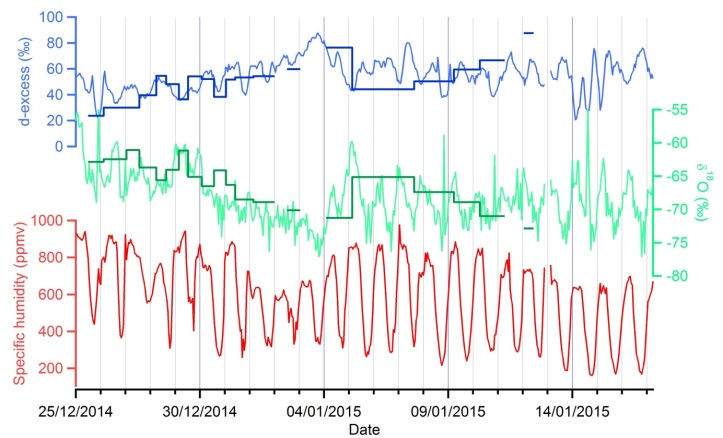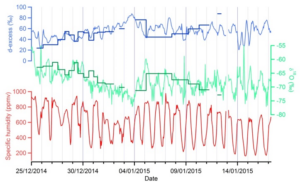Water stable isotopes in central Antarctic ice cores are critical to quantify past temperature changes. Accurate temperature reconstructions require to understand the processes controlling surface snow isotopic composition. Isotopic fractionation processes occurring in the atmosphere and controlling snowfall isotopic composition are well understood theoretically and implemented in atmospheric models. However, post-deposition processes are poorly documented and understood. To quantitatively interpret the isotopic composition of water archived in ice cores, it is thus essential to study the continuum between surface water vapour, precipitation, surface snow and buried snow.
Here, we target the isotopic composition of water vapour at Concordia Station, where the oldest EPICA Dome C ice cores have been retrieved. While snowfall and surface snow sampling is routinely performed, accurate measurements of surface water vapour are challenging in such cold and dry conditions. New developments in infrared spectroscopy enable now the measurement of isotopic composition in water vapour traces. Two infrared spectrometers have been deployed at Concordia, allowing continuous, in situ measurements for one month in December-January 2014-2015. Comparison of the results from infrared spectroscopy with laboratory measurements of discrete samples trapped using cryogenic sampling validates the relevance of the method to measure isotopic composition in dry conditions. We observe very large diurnal cycles in isotopic composition well correlated with temperature diurnal cycles. Identification of different behaviours of isotopic composition in the water vapour associated with turbulent or stratified regime indicates a strong impact of meteorological processes in local vapour/snow interaction. Even if the vapour isotopic composition seems to be, at least part of the time, at equilibrium with the local snow, the slope of δD against δ18O prevents us from identifying a unique origin leading to this isotopic composition.
Mathieu Casado, Amaelle Landais , Valérie Masson-Delmotte, Christophe Genthon, Erik Kerstel, Samir Kassi, Laurent Arnaud, Ghislain Picard, Frederic Prie, Olivier Cattani, Hans-Christian Steen-Larsen, Etienne Vignon, Peter Cermak
Atmospheric Chemistry and Physics, Vol. 16, pages 8521-8538, 20163



